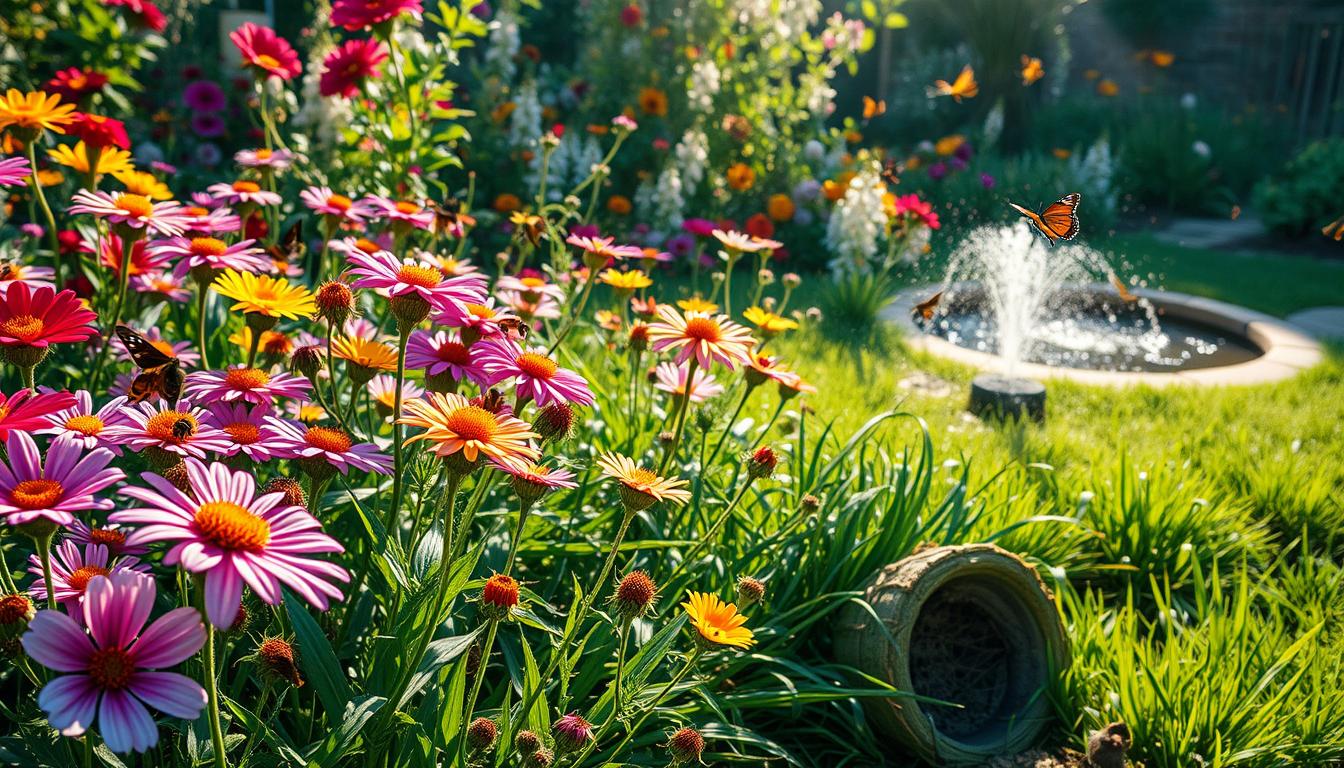As a gardener, I know how crucial it is to create a home for garden pollinators. To draw pollinators to your garden, you need the right plants and setting. In this article, I’ll share my tips for attracting pollinators and making your garden a lively haven.
Learning to attract pollinators to your garden is both fun and rewarding. By making your garden a haven for pollinators, you help these important creatures and enjoy a thriving ecosystem. With the right steps, you can make your garden a welcoming place for pollinators. I’m excited to share my knowledge with you.
In this guide, I’ll show you how to create a pollinator-friendly garden. We’ll cover choosing the right plants and building layered habitats. By following my guide, you’ll attract pollinators and create a stunning, thriving garden that supports these vital creatures.
Understanding the Importance of Pollinators
Pollinators like bees, butterflies, and hummingbirds are key to our ecosystem’s health. Without them, our gardens and crops would struggle. By making our gardens diverse, we can draw these pollinators and help their numbers grow.
To draw in pollinators, we must plant flowers, shrubs, and trees that offer food and shelter. These plants should be rich in nectar and pollen. By adding these to our gardens, we create a safe space for pollinators and boost our local ecosystem.
Why Pollinators Matter
Pollinators are crucial for many plants to reproduce. Without them, many plants can’t make seeds, threatening our food supply. By welcoming bees to our gardens, we support local pollinators and help our ecosystem thrive.
Types of Pollinators
There are many pollinators, including:
- Bees: such as honeybees and bumblebees
- Butterflies: such as monarchs and swallowtails
- Hummingbirds: such as ruby-throated hummingbirds
- Other pollinators: such as bats, moths, and wasps
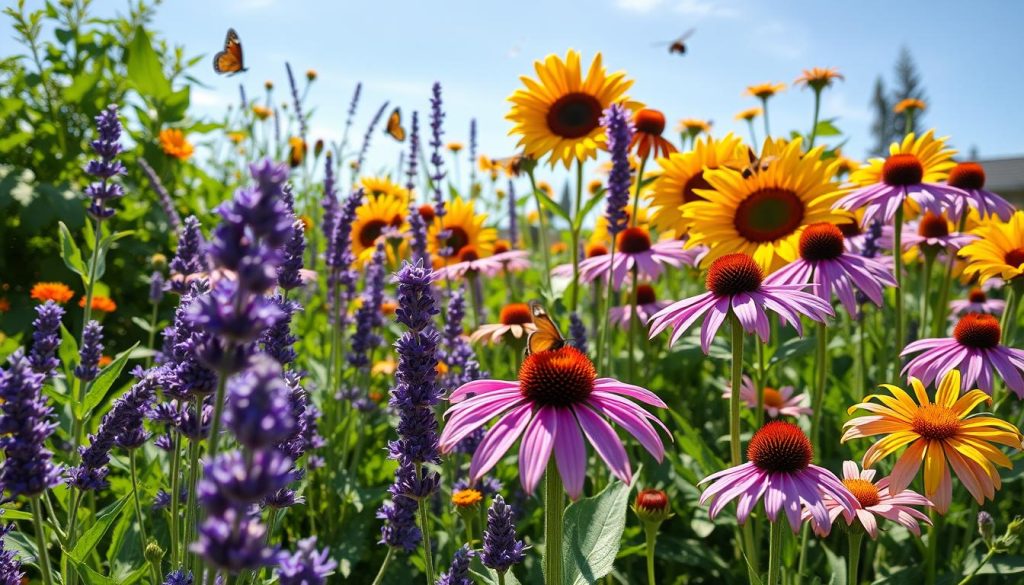
Choosing the Right Plants for Pollinators
Creating a pollinator-friendly garden starts with the right plants. Gardening for pollinators means picking plants that attract and support these important creatures. By adding pollinator-friendly plants, you create a safe haven for bees, butterflies, and more.
Here are some tips for picking the best plants:
- Opt for native plants, which are more likely to attract native pollinators
- Choose a variety of plants that bloom at different times to provide a constant source of nectar and pollen
- Incorporate plants with different heights and growth habits to create a diverse and layered garden
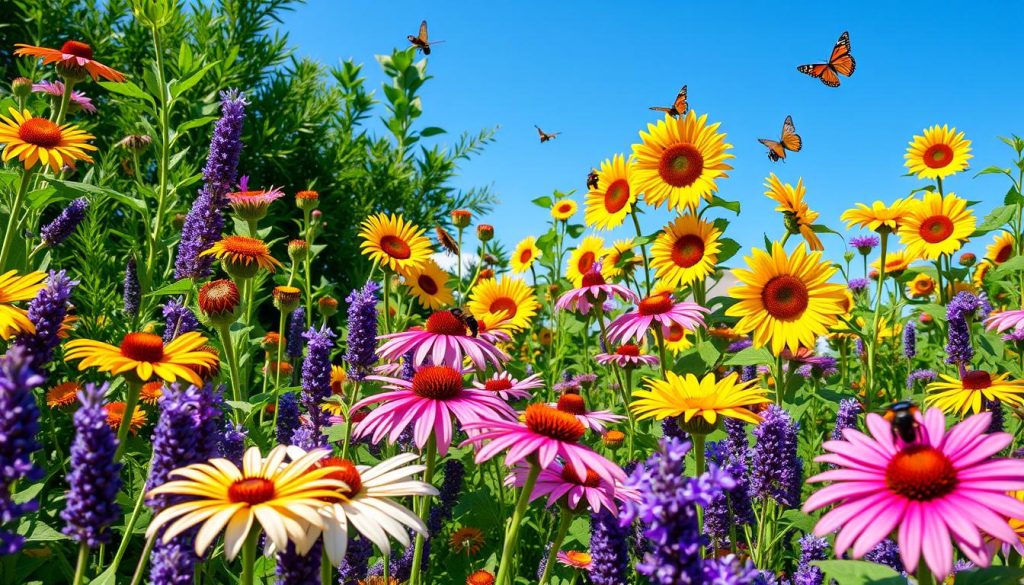
Native Plants vs. Non-Native Plants
Native plants are a great choice for a pollinator-friendly garden. They have evolved with native pollinators, making them a perfect match. Non-native plants may not support local pollinators as well.
Flowering Plants That Attract Pollinators
Some top plants for attracting pollinators include sunflowers, zinnias, and coneflowers. These plants are full of nectar and pollen, making them a hit with bees and butterflies. Adding these plants to your garden welcomes pollinators and supports their health.
Creating Layered Habitats in My Garden
To attract many garden pollinators, I need to create layered habitats. This means planting different plants at various heights. It gives pollinators food and shelter all the time. By doing this, my garden stays a lively ecosystem, supporting many species.
Some ways to achieve this include:
- Planting native flowers that attract pollinators, such as bees and butterflies
- Incorporating shrubs and trees that provide shelter and food for pollinators
- Using a mix of annuals and perennials to ensure a constant source of food throughout the growing season
Creating layered habitats helps me attract pollinators to my garden. It supports the local ecosystem and promotes biodiversity. This way, I help pollinators thrive, benefiting both me and the environment.
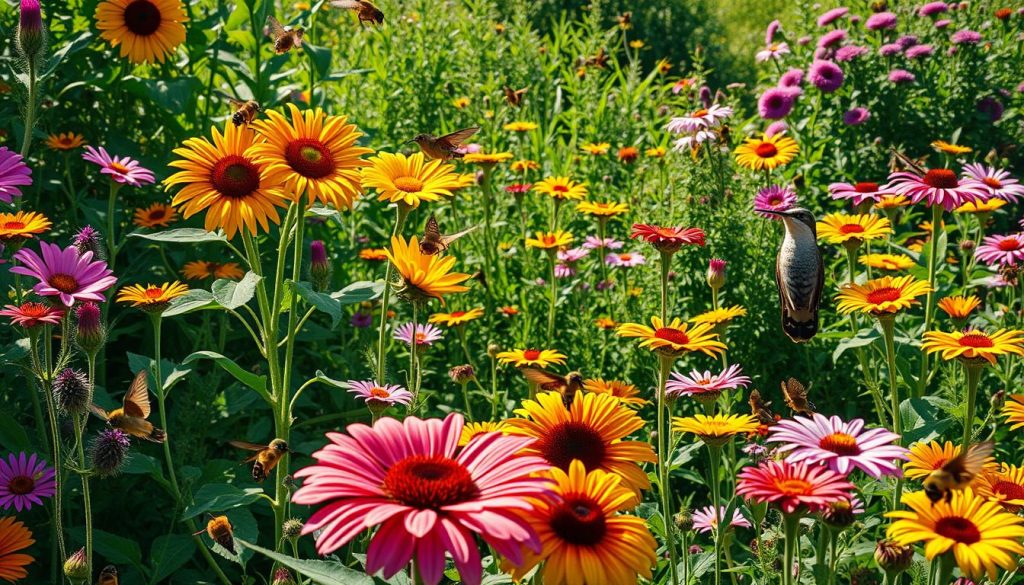
As I keep improving my garden, I’ll add more plants. These will attract pollinators and support biodiversity. My goal is to create a thriving ecosystem that benefits everyone.
Designing a Pollinator-Friendly Landscape
When designing a pollinator-friendly landscape, I think about both looks and function. I aim to make my garden welcoming by using different shapes and patterns. This means planting a variety of flowers, shrubs, and trees. These plants offer food and shelter for pollinators.
Garden Shapes and Patterns
To make my garden look good, I mix shapes and patterns. For instance, I group flowers to draw in bees and butterflies. I also use native plants to bring harmony. Here are some tips for a pollinator-friendly garden:
- Plant a mix of annuals and perennials for ongoing food.
- Choose native plants to attract native pollinators and create harmony.
- Use various shapes and patterns to make it visually interesting.
Water Sources and Their Benefits
Water sources are key for pollinators and can also beautify my garden. Options range from birdbaths to ponds. To attract pollinators, consider a butterfly garden or a bee-friendly garden with water.
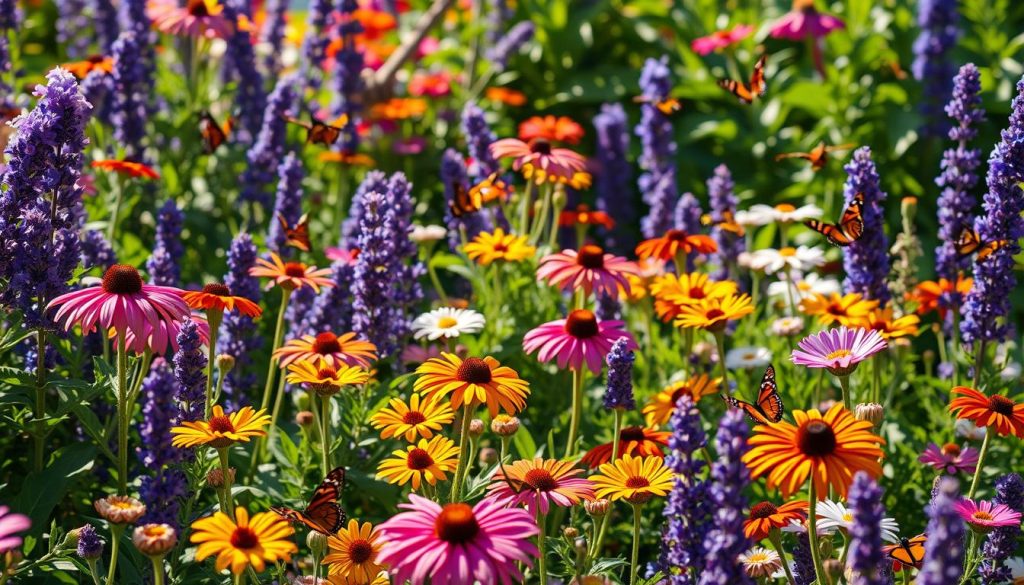
Timing Is Key: Planting Ratios and Seasons
Timing is crucial in gardening for pollinators. Planting the right plants at the right time is key to a thriving garden. Understanding seasonal blooms and planting ratios ensures a steady food supply for pollinators.
I plan my garden based on the seasons and the plants that bloom then. In spring, I plant flowers like crocuses and daffodils to attract bees and butterflies. Summer brings sunflowers and zinnias for more nectar and pollen.
Seasonal Blooms for Continuous Food Supply
Using a mix of annuals and perennials keeps my pollinators fed all season. Some great seasonal blooms include:
- Spring-blooming flowers like tulips and hyacinths
- Summer-blooming flowers like black-eyed susans and cosmos
- Fall-blooming flowers like asters and sedum
Planting Strategies to Maximize Attraction
Planting in clusters, not alone, attracts more pollinators. A diverse and abundant garden supports local pollinators. This way, I help the pollinator population and enjoy the benefits.
Pesticides and Pollinators: What You Should Know
As I tend to my garden, I’ve learned how vital it is to protect garden pollinators. Attracting these creatures is key to a healthy garden. Pesticides are a big threat to them. It’s important to know the dangers of chemical pesticides to keep our gardens safe.
To avoid harming pollinators, we should look for natural ways to fight pests. Options like neem oil, diatomaceous earth, and insecticidal soap are good choices. They help control pests without harming garden pollinators. Using these natural methods helps keep our gardens balanced and healthy for all living things.
Here are some more natural ways to keep pests away without harming pollinators:
- Encouraging beneficial insects, such as ladybugs and lacewings
- Using physical barriers, like fine mesh, to prevent pests from reaching plants
- Practicing good garden hygiene, including removing weeds and debris
By using these methods, we can lessen our use of harmful chemicals. This makes our gardens safe and welcoming for pollinators. It also helps keep our gardens diverse and healthy.
Enhancing My Garden with Pollinator Hotels
I’m making my garden a haven for pollinators. Pollinator hotels are key to this effort. They offer a cozy spot for bees and butterflies to nest and lay eggs. This way, my garden becomes a safe haven for many pollinators.
What Is a Pollinator Hotel?
A pollinator hotel is a home for pollinators. It’s made from natural stuff like bamboo and wood. You can make it simple or complex, depending on your creativity.
How to Build Your Own Pollinator Hotel
Building a pollinator hotel is a fun DIY project. You’ll need just a few materials. Here’s how to do it:
- Gather natural materials like bamboo, straws, and wood
- Cut the materials into different lengths and shapes
- Assemble the materials into a structure that provides a range of different habitats
- Place the structure in a sunny spot in your garden, like a butterfly garden, where it can attract pollinators and help with attracting bees to garden
Keeping My Garden Maintained for Pollinators
To keep my pollinators happy and healthy, I need to maintain my garden regularly. This means following seasonal tips for my pollinator-friendly plants. Gardening for pollinators needs attention to detail and flexibility to meet changing garden needs.
Some key seasonal maintenance tips include:
- Pruning plants to promote healthy growth and encourage blooming
- Weeding to prevent competition for resources and reduce the risk of disease
- Leaving some areas of the garden untidy to provide shelter and habitat for pollinators
Seasonal Maintenance Tips
By following these tips, I can create a thriving garden ecosystem. This supports my pollinator-friendly plants and boosts local garden biodiversity. Remember, gardening for pollinators is a long-term commitment that requires patience, dedication, and a willingness to learn and adapt.
The Importance of Leaving Some Dead Material
Leaving some dead material in my garden may seem odd, but it’s crucial. It provides habitat and shelter for pollinators. By embracing a more relaxed gardening approach, I can create a haven for my pollinators and enjoy a thriving garden ecosystem.
Educating Myself and Others About Pollinators
To make our community better for pollinators, we need to learn and teach others. Knowing about pollinators helps us make smart choices for our gardens. It also lets us share what we’ve learned with others.
Resources for Learning More
There are many ways to learn about pollinators. You can find books, websites, and workshops. The Xerces Society and the Pollinator Partnership are great places to start. They offer tips on how to attract pollinators and create a welcoming habitat.
Sharing My Knowledge with the Community
It’s key to share what we know about pollinators. We can join local gardening groups, go to workshops, and talk to others about our experiences. Together, we can build a network of gardens that support pollinators.
Here are some ways to help with local pollinator conservation:
- Join citizen science projects
- Volunteer with gardening groups
- Create a pollinator-friendly garden at home
By learning and teaching others about pollinators, we can positively impact our community. Sharing our knowledge and participating in local efforts helps pollinators thrive. This ensures their health and survival for the future.
| Resource | Description |
|---|---|
| Xerces Society | Provides information on pollinator conservation and habitat creation |
| Pollinator Partnership | Offers resources and guidance on creating pollinator-friendly gardens |
Observing and Enjoying Pollinators in My Garden
As I sit in my garden, I feel joy and wonder. The plants I’ve chosen bring vibrant colors and sweet scents. Bees, butterflies, and other insects visit, making my garden a haven for them.
Designing a butterfly garden has been rewarding. It’s not just about attracting bees. It’s about creating a space for all pollinators. I’m eager to share my journey with others.
To enjoy my garden fully, I’ve learned some tips. Here are a few:
- Plant a variety of flowers that bloom at different times to provide a constant source of nectar and pollen for pollinators.
- Provide a source of water, such as a shallow dish or birdbath, for pollinators to drink from.
- Avoid using pesticides, which can harm or kill pollinators, and instead use natural methods to control pests.
Tips for Pollinator Watching
By following these tips, I’ve attracted many pollinators. I’ve learned to appreciate the importance of a pollinator-friendly garden. I also document my experiences, taking photos and notes.
Documenting My Experience
Documenting my experience has taught me a lot. It’s also helped me share my knowledge. By creating a pollinator-friendly garden, I’ve gained a new appreciation for these insects.
| Plant | Pollinators Attracted |
|---|---|
| Lavender | Bees, butterflies |
| Sunflowers | Bees, butterflies, hummingbirds |
| Zinnias | Butterflies, bees, ladybugs |
Celebrating Success: My Pollinator-Friendly Garden Journey
Reflecting on my pollinator-friendly garden journey fills me with pride. Over time, my outdoor space has turned into a thriving oasis. It’s a testament to the power of conscious gardening.
Watching my pollinator-friendly plants bloom in vibrant colors is rewarding. They attract a variety of buzzing, fluttering, and graceful visitors. The garden biodiversity I’ve created brings me joy, as I marvel at nature’s balance.
The real satisfaction is knowing my garden supports local pollinators. Seeing bees, butterflies, and hummingbirds thrive fills me with purpose. I know I’m helping sustain our ecosystem’s health.
Looking ahead, I’m excited to share my passion for gardening for pollinators. I hope to inspire others to create their own pollinator-friendly gardens. Together, we can celebrate the vital role of pollinators and the importance of biodiversity in our communities.

